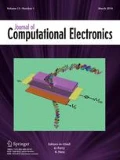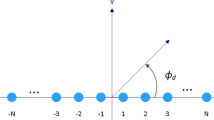Abstract
Today, the design of antenna arrays is very important in providing effective and efficient wireless communication. The purpose of antenna array synthesis is to obtain a radiation pattern with a low side lobe level (SLL) at a desired half power beam width in far-field. The amplitude and position values of the array elements can be optimized to obtain a radiation pattern with suppressed SLLs. In this paper, swarm-based metaheuristic algorithms including particle swarm optimization (PSO), artificial bee colony (ABC), mayfly algorithm (MA) and jellyfish search (JS) are compared to determine the optimal design of linear antenna arrays. Extensive experiments are conducted on designing 10-, 16-, 24- and 32-element linear arrays by determining the amplitude and positions. Experiments are repeated 30 times due to the random nature of swarm-based optimizers, and statistical results show that the performance of the novel algorithms, MA and JS, is better than that of the well-known PSO and ABC methods.










Similar content being viewed by others
References
Balanis, C.A.: Antenna Theory: Analysis and Design. Wiley (2016)
Mailloux, R.J.: Phased Array Antenna Handbook. Artech house (2017)
Guney, K., Durmus, A., Basbug, S.: A plant growth simulation algorithm for pattern nulling of linear antenna arrays by amplitude control. Prog. Electromagn. Res. 17, 69–84 (2009)
Dib, N.I.: Design of linear antenna arrays with low side lobes level using symbiotic organisms search. Prog. Electromagn. Res. 68, 55–71 (2016)
Sharaqa, A., Dib, N.: Design of linear and elliptical antenna arrays using biogeography based optimization. Arab. J. Sci. Eng. 39(4), 2929–2939 (2014)
Khodier, M.M., Al-Aqeel, M.: Linear and circular array optimization: a study using particle swarm intelligence. Prog. Electromagn. Res. 15, 347–373 (2009)
Dib, N.I., Goudos, S.K., Muhsen, H.: Application of Taguchi’s optimization method and self-adaptive differential evolution to the synthesis of linear antenna arrays. Prog. Electromagn. Res. 102, 159–180 (2010)
Das, A., Mandal, D., Ghoshal, S.P., Kar, R.: Moth flame optimization based design of linear and circular antenna array for side lobe reduction. Int. J. Numer. Model. Electron. Netw. Dev. Fields 32(1), e2486 (2019)
Subhashini, K.R.: Runner-root algorithm to control sidelobe level and null depths in linear antenna arrays. Arab. J. Sci. Eng. 45(3), 1513–1529 (2020)
Zaman, M.A., Gaffar, M., Alam, M.M., Mamun, S.A., Matin, M.A.: Synthesis of antenna arrays using artificial bee colony optimization algorithm. Int. J. Microwave Opt. Technol. 6(4), 234–241 (2011)
Basu, B., Mahanti, G.K.: Fire fly and artificial bees colony algorithm for synthesis of scanned and broadside linear array antenna. Prog. Electromagn. Res. 32, 169–190 (2011)
Khodier, M.: Comprehensive study of linear antenna array optimisation using the cuckoo search algorithm. IET Microw. Antennas Propag. 13(9), 1325–1333 (2019)
Zhang, R., Zhang, Y., Sun, J., Li, Q.: Pattern synthesis of linear antenna array using improved differential evolution algorithm with SPS framework. Sensors 20(18), 5158 (2020)
Liang, S., Fang, Z., Sun, G., Liu, Y., Qu, G., Zhang, Y.: Sidelobe reductions of antenna arrays via an improved chicken swarm optimization approach. IEEE Access 8, 37664–37683 (2020)
Subhashini, K.R.: Antenna array synthesis using a newly evolved optimization approach: strawberry algorithm. J. Electr. Eng. 70(4), 317–322 (2019)
Wolpert, D.H., Macready, W.G.: No free lunch theorems for optimization. IEEE Trans. Evol. Comput. 1(1), 67–82 (1997)
Durmus, A., Kurban, R.: Optimum design of linear and circular antenna arrays using equilibrium optimization algorithm. Int. J. Microwave Wirel. Technol. 1–12 (2021)
Kennedy, J., Eberhart, R. Particle swarm optimization. In: Proceedings of ICNN'95-International Conference on Neural Networks, vol. 4, pp. 1942–1948. IEEE. (1995)
Karaboga, D., Basturk, B.: A powerful and efficient algorithm for numerical function optimization: artificial bee colony (ABC) algorithm. J. Global Optim. 39(3), 459–471 (2007)
Zervoudakis, K., Tsafarakis, S.: A mayfly optimization algorithm. Comput. Ind. Eng. 145, 106559 (2020)
Chou, J.-S., Truong, D.-N.: A novel metaheuristic optimizer inspired by behavior of jellyfish in ocean. Appl. Math. Comput. 389, 125535 (2021)
Author information
Authors and Affiliations
Corresponding author
Additional information
Publisher's Note
Springer Nature remains neutral with regard to jurisdictional claims in published maps and institutional affiliations.
Rights and permissions
About this article
Cite this article
Durmus, A., Kurban, R. & Karakose, E. A comparison of swarm-based optimization algorithms in linear antenna array synthesis. J Comput Electron 20, 1520–1531 (2021). https://doi.org/10.1007/s10825-021-01711-w
Received:
Accepted:
Published:
Issue Date:
DOI: https://doi.org/10.1007/s10825-021-01711-w




